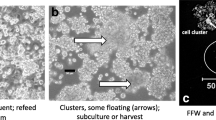Abstract
High yields of the copepodCyclops vernalis infected with the mosquito-parasitic fungusCoelomomyces dodgei Couch & Dodge were obtained by infecting nauplii in large synchronously developing populations. Exposure of 2000 48 or 72 h old nauplii to 6×103 sporangia at the time of meiospore release yielded ca. 1500 infected copepods. Based on yields of infected copepods, susceptibility ofC. vernalis toC. dodgei decreased as copepods developed. Infection rates were 75% for copepods exposed as 48 or 72 h old nauplii but declined to 32 and 9.6%, respectively, for those exposed as copepodids or adults. The relevance of these results for domestication of other species ofCoelomomyces and studies on non-target organisms is discussed, and improved procedures for routine production ofC. dodgei are described.
Résumé
Des rendements élevés en copépodes,Cyclops vernalis infectés par le champignon parasite des moustiques,Coelomomyces dodgei Couch & Dodge ont été obtenus en contaminant les nauplii de populations importantes se développant de façon synchrone. L’exposition pendant 48 ou 72 h de 2 000 nauplii âgés à 6.103 sporanges au stade d’émission des méiospores produit environ 1 500 copépodes infectés. Le taux de copépodes infectés, c’est-à-dire la sensibilité deC. vernalis au champignon, décroit avec le développement du crustacé. Ces taux sont de 75% dans le cas de nauplii âgés et de 32 et 9,6% respectivement dans le cas de copépodides ou d’adultes. Les conséquences de ces résultats, pour la multiplication d’autres espèces deCoelomomyces et les essais sur leur activité à l’égard des organismes non visés, sont discutées. Un procédé amélioré de production de routine deC. dodgei est décrit.
Similar content being viewed by others
References
Chapman, H. C. — 1974. Biological control of mosquito larvae. —Annu. Rev. Entomol., 19, 33–59.
Couch, J. N. — 1972. Mass production ofCoelomomyces, a fungus that kills mosquitoes. —Proc. Nat. Acad. Sci. U.S.A., 69, 2043–2047.
Federici, B. A. — 1980. Fungi: Mosquito control byCulicinomyces, Lagenidium, andCoelomomyces.In: Microbial Control of Insects, Mites, and Plant Diseases (H. D. Burges, ed.). —Academic Press, N. Y. & Lond.
Federici, B. A. &Roberts, D. W. — 1976. Experimental laboratory infection of mosquito larvae with fungi of the genusCoelomomyces. II. Experiments withCoelomomyces punctatus inAnopheles quadrimaculatus. —J. Invertebr. Pathol., 27, 333–341.
Federici, B. A. &Chapman, H. C. — 1977.Coelomomyces dodgei: establishment of anin vivo laboratory culture. —J. Invertebr. Pathol., 30, 288–297.
Travland, L. B. — 1979. Initiation of infection of mosquito larvae (Culiseta inornata) byCoelomomyces psorophorae. —J. Invertebr. Pathol., 33, 95–105.
Whisler, H. C. — 1979. The fungi versus the arthropods. In: Insect-Fungus Symbiosis (L. R. Batra, ed.). Ch. 1. —Allanheld, Osmum, Inc., Montclair, New Jersey, 1–32.
Whisler, H. C., Zebold, S. L. &Shemanchuk, J. A. — 1975. Life history ofCoelomomyces psorophorae. —Proc. Nat. Acad. Sci. U.S.A., 72, 693–696.
Author information
Authors and Affiliations
Rights and permissions
About this article
Cite this article
Federici, B.A. Production of the mosquito-parasitic fungus,Coelomomyces dodgei, through synchronized infection and growth of the intermediate copepod host,Cyclops vernalis . Entomophaga 25, 209–217 (1980). https://doi.org/10.1007/BF02374322
Issue Date:
DOI: https://doi.org/10.1007/BF02374322




